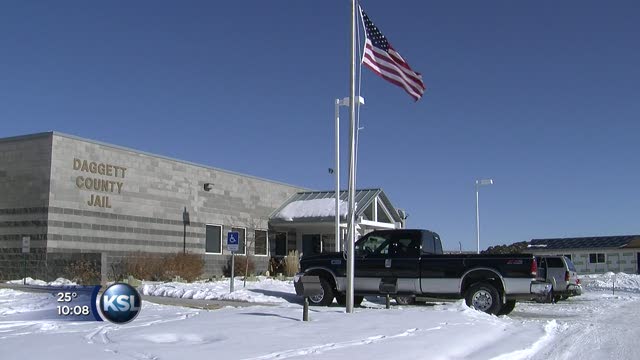Estimated read time: 4-5 minutes
This archived news story is available only for your personal, non-commercial use. Information in the story may be outdated or superseded by additional information. Reading or replaying the story in its archived form does not constitute a republication of the story.
MANILA, Daggett County— Sheriff Jerry Jorgensen has plenty of experience putting people behind bars.
He also knows how to keep them there.
Jorgensen's 34-year career in public safety includes nearly 15 years with the Utah Department of Corrections, where he served as a warden and a deputy warden before retiring in 2005 and moving to Daggett County.
Two years later, his experience made Jorgensen the logical choice to be commander of the Daggett County Jail after two state inmates serving time at the facility escaped.
On Sept. 23, 2007, convicted killers Danny Martin Gallegos and Juan Carlos Diaz-Arevelo used a group of inmates entering the jail from a makeshift housing unit known as the "Green House," to slip outside and escape from the poorly secured perimeter.

The men burglarized a nearby cabin, tied up the owner and stole his SUV. Their freedom lasted only six days and ended after they exchanged gunfire with police in Wyoming.
Both men were sent back to prison, where Gallegos committed suicide in June 2009. Diaz-Arevelo isn't scheduled to appear before the parole board until May 2030.
Jorgensen agreed to assume command of the jail in the aftermath of the escape. That aftermath included the immediate removal of all state inmates from the jail, a legislative audit of Utah's jail contracting program, and a security review by the Utah Department of Corrections that revealed "systemic" and "significant" problems at the facility.
"There were a lot of deficiencies in the way the operation was run," said Jorgensen, who was sworn-in as sheriff in January and gave the Deseret News a tour of the jail Thursday.
At the time of the escape, inmates were allowed to move freely throughout the entire facility, including the administrative offices, he said. Minimum staffing levels were established, but not followed. There was inadequate perimeter fencing and only about two dozen surveillance cameras inside the jail and out.
One of the biggest concerns, however, was the Green House, where as many as 30 inmates were housed without officer supervision.
"The Green House was kind of a free-for-all," Jorgensen said. "Inmates were managing themselves. ... It's not a good thing, and it ruined the security of the jail."
Fast-forward four years and many of the changes are easy to see. Others are not.
They did discover quite a few different things that they needed to fix, and to their credit, they've been good partners at going back and fixing those things.
–Steve Gehrke, Utah Department of Corrections
The Green House is gone. It was torn down over the summer around the same time an inmate crew from the state prison completed work on the new perimeter fences.
"The double fences were not here (at the time of the escape)," the sheriff said, standing between two towering walls of chain link topped with concertina razor wire that glistened in the brilliant December sun.
"Corrections actually designed the system for us," Jorgensen said, adding that there's a cement barrier under the fence.
"So there's no tunneling either," he said.
More razor wire now rings the roof of the jail as well to prevent inmates from following Gallegos and Diaz-Arevelo's escape route. And as many as 70 cameras keep an eye on the entire facility.
But the changes go beyond the demolition of a building and the addition of more barbed wire and security cameras. There's now a screening process in place to help the sheriff determine which state inmates he'll accept.
So far, Jorgensen has rejected about 300 state inmates who were approved by Corrections staff for housing in Daggett County.
"I screen them against their crime, against escape risks, against disciplinary issues, against their medical (issues), against gang activities," the sheriff said.
He also mandates strict adherence to the minimum staffing plan he's adopted and requires his corrections officers to treat all inmates fairly and with dignity.
"I would much rather be here (than at the prison)," one state inmate told the Deseret News. "They treat you with a lot of respect. That means a lot to an inmate."
The changes have not gone unnoticed by officials with the Utah Department of Corrections.
"They did discover quite a few different things that they needed to fix and, to their credit, they've been good partners at going back and fixing those things," said Corrections spokesman Steve Gehrke.
"They're to be applauded for the efforts they've made," he added.
Jorgensen won't go so far as to call his facility escape proof, but he says the combination of physical and management changes should greatly reduce the chances of another jailbreak.
"My confidence in this place is pretty good right now," he said.
Email: gliesik@ksl.com










